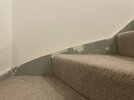- Joined
- 28 Apr 2021
- Messages
- 285
- Reaction score
- 3
- Country

I have a winder staircase that has a section of stringer that has three cuts that form a sort of curve. The corners of the cuts have been rounded a bit too. I’d like to add a quadrant to the top of the stringer - I was going to use a rip cut of a bullnose mdf architrave here because the stringer is a bit too wide on this wall to use a quadrant. I’m not sure whether to try and cut three pieces to fit these cuts, or try and bend a piece of the mdf and fill the gaps between it and the stringer somehow. What do you reckon?

